Detailed Comparison of AGR and PWR Nuclear Reactor Technologies
VerifiedAdded on 2023/06/11
|12
|1959
|463
Report
AI Summary
This report provides a comprehensive comparison of Advanced Gas-Cooled Reactors (AGR) and Pressurized Water Reactors (PWR), focusing on their chemical reactions, operational mechanisms, benefits, and drawbacks. It details the fuel processes, coolants, and moderators used in each reactor type, highlighting the chemical reactions involved, such as the formation of uranium carbide in AGRs and the oxidation of uranium dioxide in PWRs. The report also compares the advantages and disadvantages of each reactor, including safety aspects, fuel requirements, power density, and thermal efficiency. Ultimately, the analysis suggests that AGRs may offer enhanced safety due to their design and components. Desklib provides students access to past papers and solved assignments for similar topics.
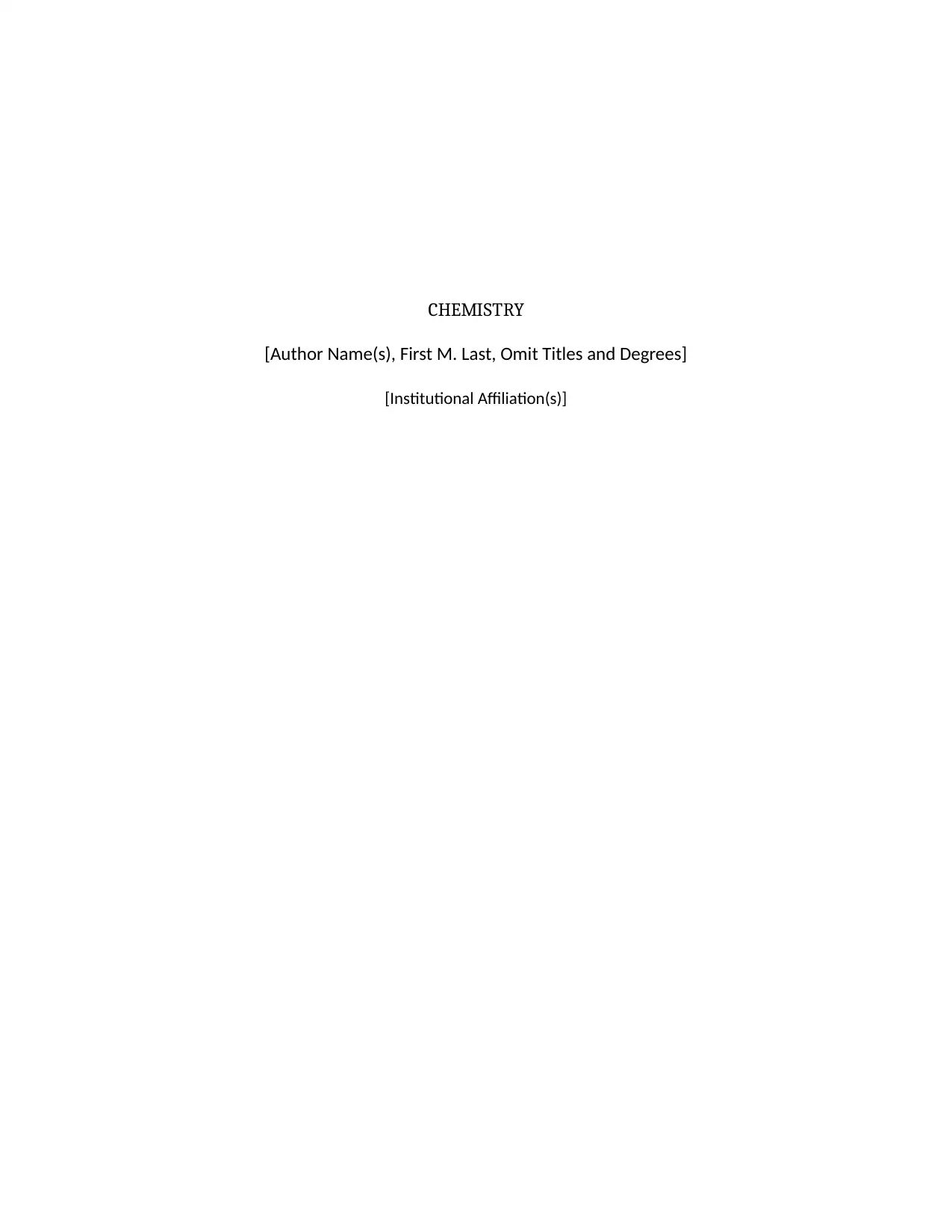
CHEMISTRY
[Author Name(s), First M. Last, Omit Titles and Degrees]
[Institutional Affiliation(s)]
[Author Name(s), First M. Last, Omit Titles and Degrees]
[Institutional Affiliation(s)]
Paraphrase This Document
Need a fresh take? Get an instant paraphrase of this document with our AI Paraphraser
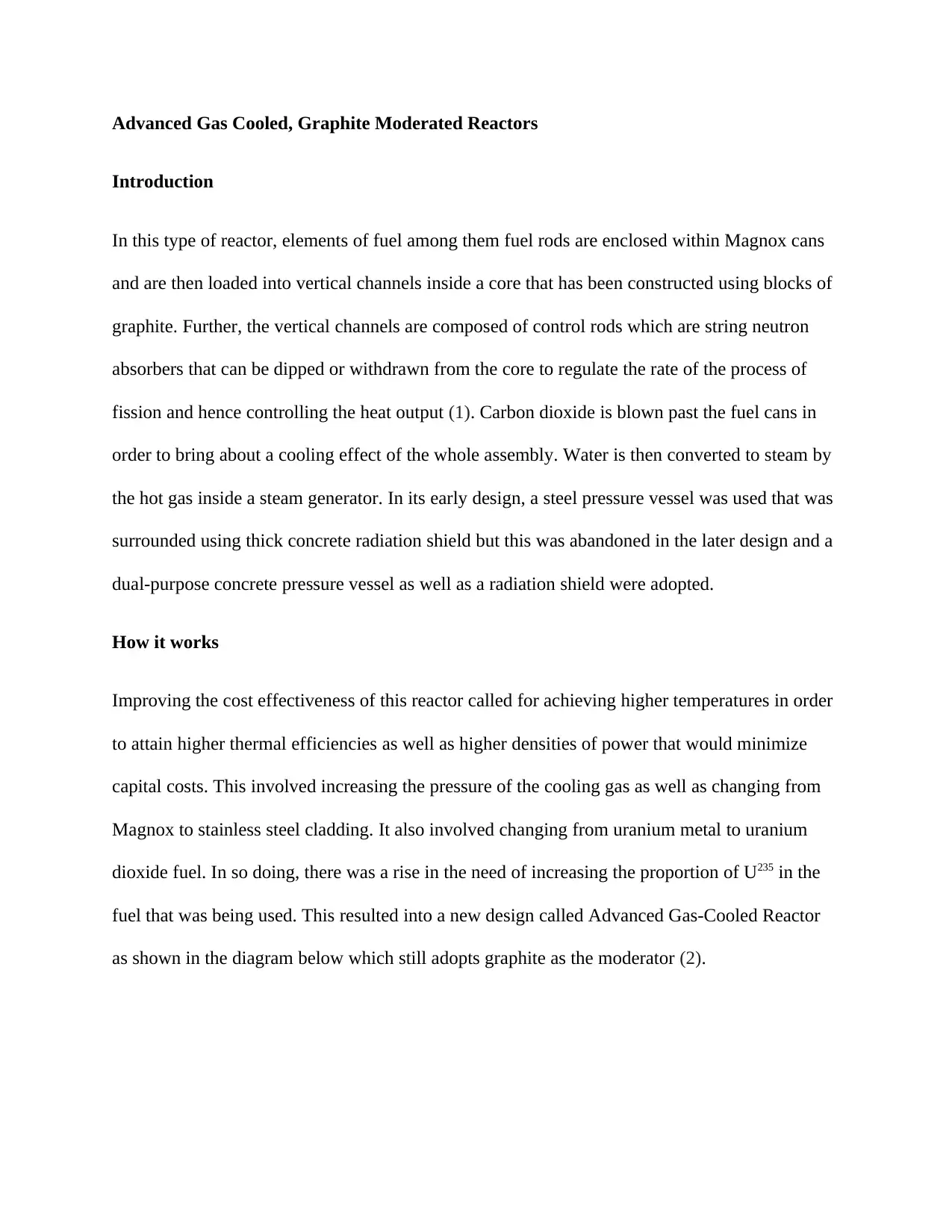
Advanced Gas Cooled, Graphite Moderated Reactors
Introduction
In this type of reactor, elements of fuel among them fuel rods are enclosed within Magnox cans
and are then loaded into vertical channels inside a core that has been constructed using blocks of
graphite. Further, the vertical channels are composed of control rods which are string neutron
absorbers that can be dipped or withdrawn from the core to regulate the rate of the process of
fission and hence controlling the heat output (1). Carbon dioxide is blown past the fuel cans in
order to bring about a cooling effect of the whole assembly. Water is then converted to steam by
the hot gas inside a steam generator. In its early design, a steel pressure vessel was used that was
surrounded using thick concrete radiation shield but this was abandoned in the later design and a
dual-purpose concrete pressure vessel as well as a radiation shield were adopted.
How it works
Improving the cost effectiveness of this reactor called for achieving higher temperatures in order
to attain higher thermal efficiencies as well as higher densities of power that would minimize
capital costs. This involved increasing the pressure of the cooling gas as well as changing from
Magnox to stainless steel cladding. It also involved changing from uranium metal to uranium
dioxide fuel. In so doing, there was a rise in the need of increasing the proportion of U235 in the
fuel that was being used. This resulted into a new design called Advanced Gas-Cooled Reactor
as shown in the diagram below which still adopts graphite as the moderator (2).
Introduction
In this type of reactor, elements of fuel among them fuel rods are enclosed within Magnox cans
and are then loaded into vertical channels inside a core that has been constructed using blocks of
graphite. Further, the vertical channels are composed of control rods which are string neutron
absorbers that can be dipped or withdrawn from the core to regulate the rate of the process of
fission and hence controlling the heat output (1). Carbon dioxide is blown past the fuel cans in
order to bring about a cooling effect of the whole assembly. Water is then converted to steam by
the hot gas inside a steam generator. In its early design, a steel pressure vessel was used that was
surrounded using thick concrete radiation shield but this was abandoned in the later design and a
dual-purpose concrete pressure vessel as well as a radiation shield were adopted.
How it works
Improving the cost effectiveness of this reactor called for achieving higher temperatures in order
to attain higher thermal efficiencies as well as higher densities of power that would minimize
capital costs. This involved increasing the pressure of the cooling gas as well as changing from
Magnox to stainless steel cladding. It also involved changing from uranium metal to uranium
dioxide fuel. In so doing, there was a rise in the need of increasing the proportion of U235 in the
fuel that was being used. This resulted into a new design called Advanced Gas-Cooled Reactor
as shown in the diagram below which still adopts graphite as the moderator (2).
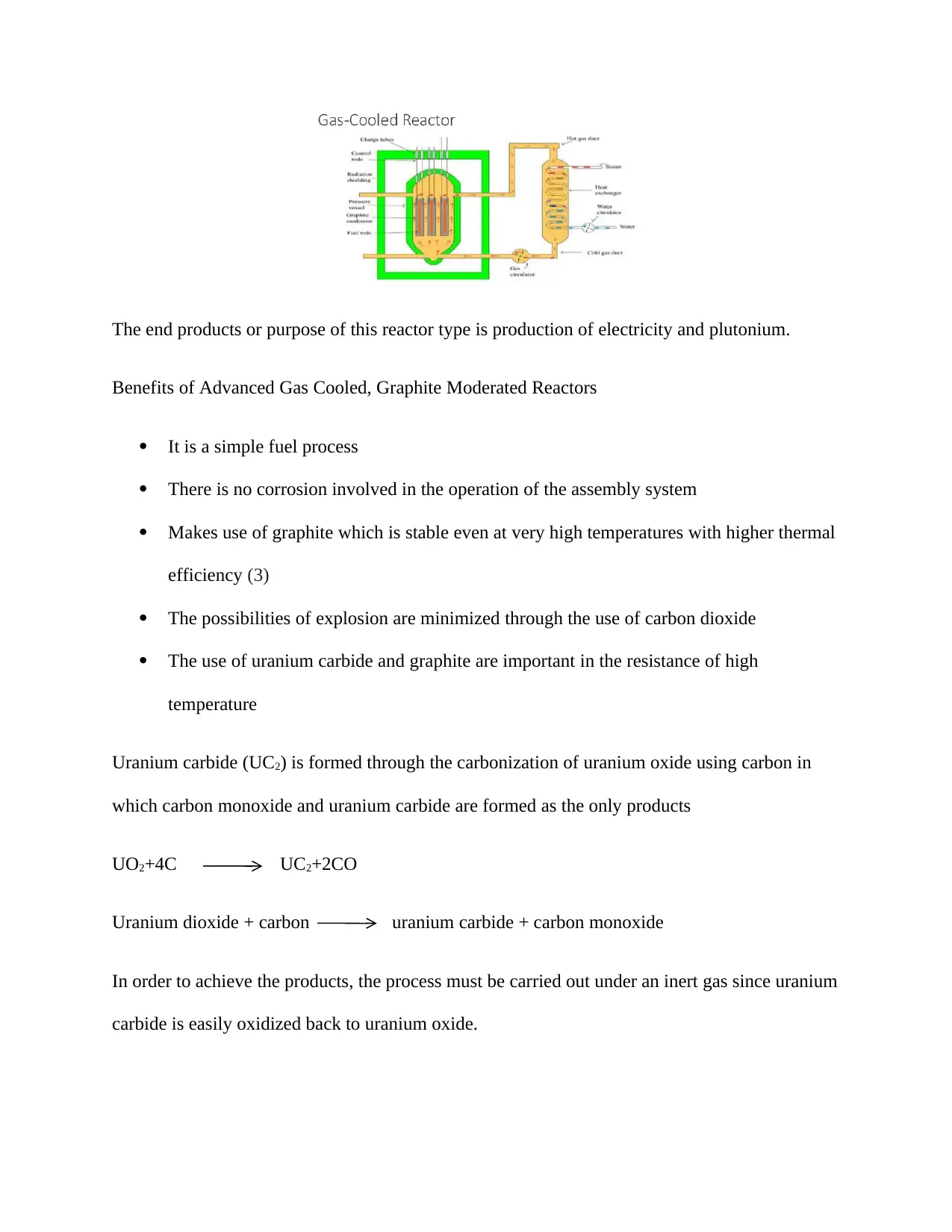
The end products or purpose of this reactor type is production of electricity and plutonium.
Benefits of Advanced Gas Cooled, Graphite Moderated Reactors
It is a simple fuel process
There is no corrosion involved in the operation of the assembly system
Makes use of graphite which is stable even at very high temperatures with higher thermal
efficiency (3)
The possibilities of explosion are minimized through the use of carbon dioxide
The use of uranium carbide and graphite are important in the resistance of high
temperature
Uranium carbide (UC2) is formed through the carbonization of uranium oxide using carbon in
which carbon monoxide and uranium carbide are formed as the only products
UO2+4C UC2+2CO
Uranium dioxide + carbon uranium carbide + carbon monoxide
In order to achieve the products, the process must be carried out under an inert gas since uranium
carbide is easily oxidized back to uranium oxide.
Benefits of Advanced Gas Cooled, Graphite Moderated Reactors
It is a simple fuel process
There is no corrosion involved in the operation of the assembly system
Makes use of graphite which is stable even at very high temperatures with higher thermal
efficiency (3)
The possibilities of explosion are minimized through the use of carbon dioxide
The use of uranium carbide and graphite are important in the resistance of high
temperature
Uranium carbide (UC2) is formed through the carbonization of uranium oxide using carbon in
which carbon monoxide and uranium carbide are formed as the only products
UO2+4C UC2+2CO
Uranium dioxide + carbon uranium carbide + carbon monoxide
In order to achieve the products, the process must be carried out under an inert gas since uranium
carbide is easily oxidized back to uranium oxide.
⊘ This is a preview!⊘
Do you want full access?
Subscribe today to unlock all pages.

Trusted by 1+ million students worldwide
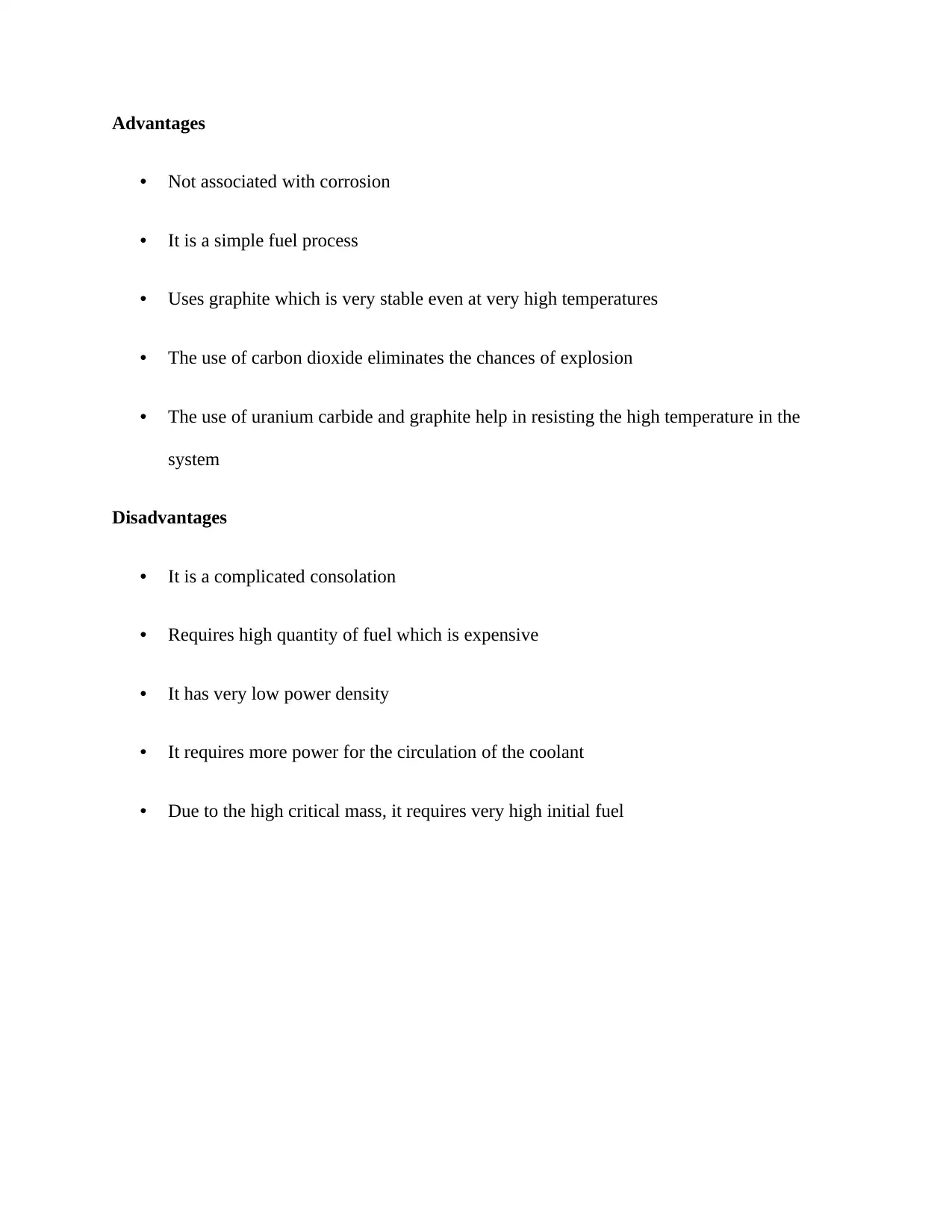
Advantages
• Not associated with corrosion
• It is a simple fuel process
• Uses graphite which is very stable even at very high temperatures
• The use of carbon dioxide eliminates the chances of explosion
• The use of uranium carbide and graphite help in resisting the high temperature in the
system
Disadvantages
• It is a complicated consolation
• Requires high quantity of fuel which is expensive
• It has very low power density
• It requires more power for the circulation of the coolant
• Due to the high critical mass, it requires very high initial fuel
• Not associated with corrosion
• It is a simple fuel process
• Uses graphite which is very stable even at very high temperatures
• The use of carbon dioxide eliminates the chances of explosion
• The use of uranium carbide and graphite help in resisting the high temperature in the
system
Disadvantages
• It is a complicated consolation
• Requires high quantity of fuel which is expensive
• It has very low power density
• It requires more power for the circulation of the coolant
• Due to the high critical mass, it requires very high initial fuel
Paraphrase This Document
Need a fresh take? Get an instant paraphrase of this document with our AI Paraphraser
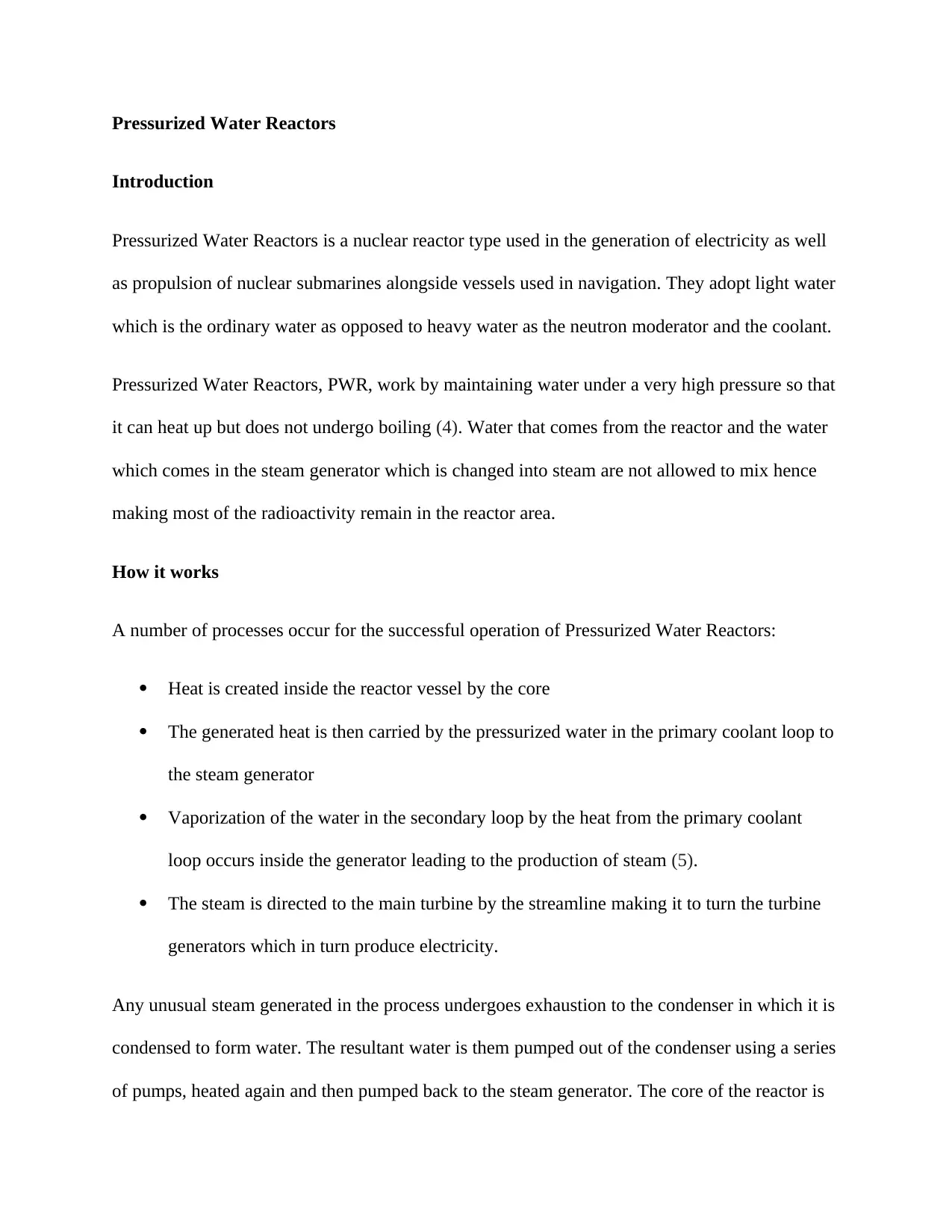
Pressurized Water Reactors
Introduction
Pressurized Water Reactors is a nuclear reactor type used in the generation of electricity as well
as propulsion of nuclear submarines alongside vessels used in navigation. They adopt light water
which is the ordinary water as opposed to heavy water as the neutron moderator and the coolant.
Pressurized Water Reactors, PWR, work by maintaining water under a very high pressure so that
it can heat up but does not undergo boiling (4). Water that comes from the reactor and the water
which comes in the steam generator which is changed into steam are not allowed to mix hence
making most of the radioactivity remain in the reactor area.
How it works
A number of processes occur for the successful operation of Pressurized Water Reactors:
Heat is created inside the reactor vessel by the core
The generated heat is then carried by the pressurized water in the primary coolant loop to
the steam generator
Vaporization of the water in the secondary loop by the heat from the primary coolant
loop occurs inside the generator leading to the production of steam (5).
The steam is directed to the main turbine by the streamline making it to turn the turbine
generators which in turn produce electricity.
Any unusual steam generated in the process undergoes exhaustion to the condenser in which it is
condensed to form water. The resultant water is them pumped out of the condenser using a series
of pumps, heated again and then pumped back to the steam generator. The core of the reactor is
Introduction
Pressurized Water Reactors is a nuclear reactor type used in the generation of electricity as well
as propulsion of nuclear submarines alongside vessels used in navigation. They adopt light water
which is the ordinary water as opposed to heavy water as the neutron moderator and the coolant.
Pressurized Water Reactors, PWR, work by maintaining water under a very high pressure so that
it can heat up but does not undergo boiling (4). Water that comes from the reactor and the water
which comes in the steam generator which is changed into steam are not allowed to mix hence
making most of the radioactivity remain in the reactor area.
How it works
A number of processes occur for the successful operation of Pressurized Water Reactors:
Heat is created inside the reactor vessel by the core
The generated heat is then carried by the pressurized water in the primary coolant loop to
the steam generator
Vaporization of the water in the secondary loop by the heat from the primary coolant
loop occurs inside the generator leading to the production of steam (5).
The steam is directed to the main turbine by the streamline making it to turn the turbine
generators which in turn produce electricity.
Any unusual steam generated in the process undergoes exhaustion to the condenser in which it is
condensed to form water. The resultant water is them pumped out of the condenser using a series
of pumps, heated again and then pumped back to the steam generator. The core of the reactor is
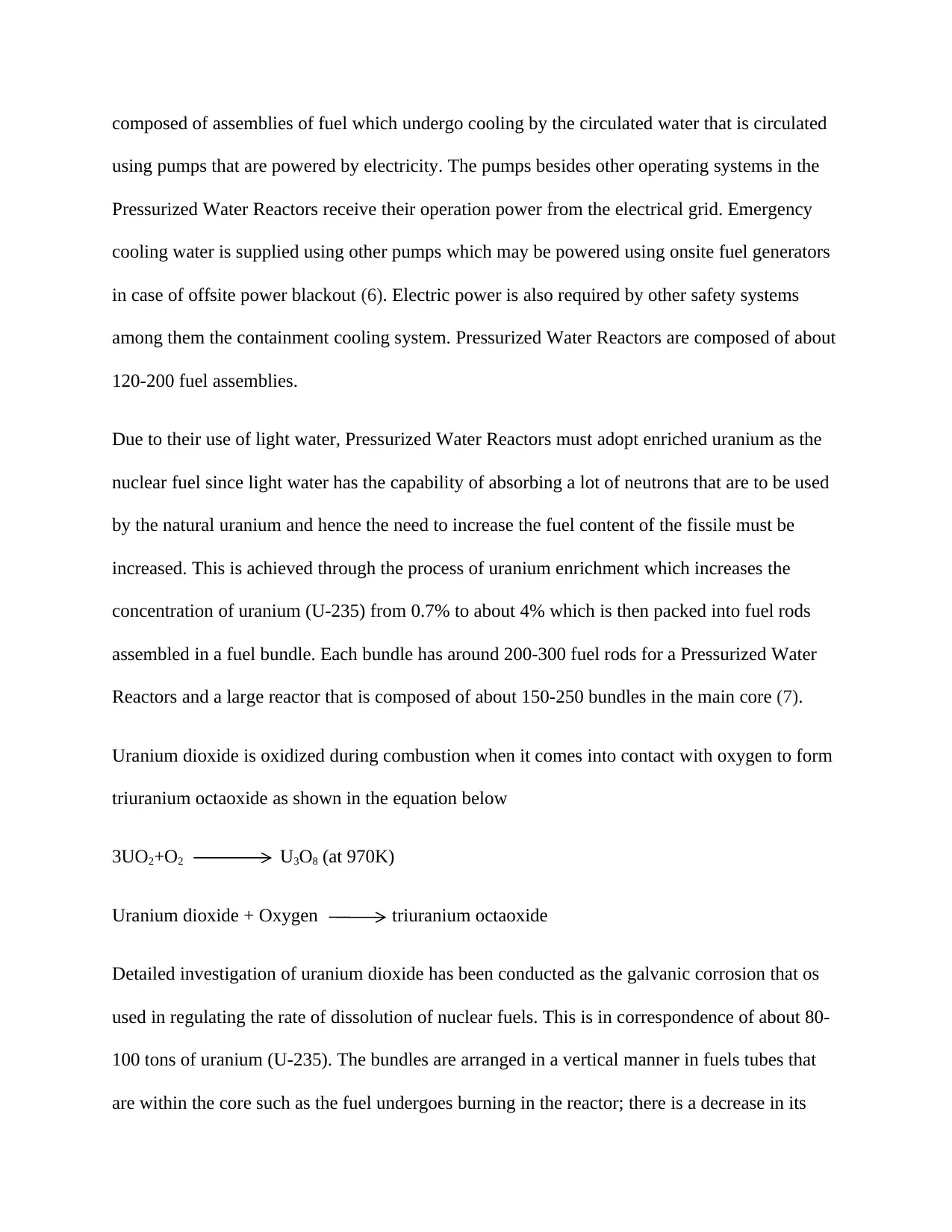
composed of assemblies of fuel which undergo cooling by the circulated water that is circulated
using pumps that are powered by electricity. The pumps besides other operating systems in the
Pressurized Water Reactors receive their operation power from the electrical grid. Emergency
cooling water is supplied using other pumps which may be powered using onsite fuel generators
in case of offsite power blackout (6). Electric power is also required by other safety systems
among them the containment cooling system. Pressurized Water Reactors are composed of about
120-200 fuel assemblies.
Due to their use of light water, Pressurized Water Reactors must adopt enriched uranium as the
nuclear fuel since light water has the capability of absorbing a lot of neutrons that are to be used
by the natural uranium and hence the need to increase the fuel content of the fissile must be
increased. This is achieved through the process of uranium enrichment which increases the
concentration of uranium (U-235) from 0.7% to about 4% which is then packed into fuel rods
assembled in a fuel bundle. Each bundle has around 200-300 fuel rods for a Pressurized Water
Reactors and a large reactor that is composed of about 150-250 bundles in the main core (7).
Uranium dioxide is oxidized during combustion when it comes into contact with oxygen to form
triuranium octaoxide as shown in the equation below
3UO2+O2 U3O8 (at 970K)
Uranium dioxide + Oxygen triuranium octaoxide
Detailed investigation of uranium dioxide has been conducted as the galvanic corrosion that os
used in regulating the rate of dissolution of nuclear fuels. This is in correspondence of about 80-
100 tons of uranium (U-235). The bundles are arranged in a vertical manner in fuels tubes that
are within the core such as the fuel undergoes burning in the reactor; there is a decrease in its
using pumps that are powered by electricity. The pumps besides other operating systems in the
Pressurized Water Reactors receive their operation power from the electrical grid. Emergency
cooling water is supplied using other pumps which may be powered using onsite fuel generators
in case of offsite power blackout (6). Electric power is also required by other safety systems
among them the containment cooling system. Pressurized Water Reactors are composed of about
120-200 fuel assemblies.
Due to their use of light water, Pressurized Water Reactors must adopt enriched uranium as the
nuclear fuel since light water has the capability of absorbing a lot of neutrons that are to be used
by the natural uranium and hence the need to increase the fuel content of the fissile must be
increased. This is achieved through the process of uranium enrichment which increases the
concentration of uranium (U-235) from 0.7% to about 4% which is then packed into fuel rods
assembled in a fuel bundle. Each bundle has around 200-300 fuel rods for a Pressurized Water
Reactors and a large reactor that is composed of about 150-250 bundles in the main core (7).
Uranium dioxide is oxidized during combustion when it comes into contact with oxygen to form
triuranium octaoxide as shown in the equation below
3UO2+O2 U3O8 (at 970K)
Uranium dioxide + Oxygen triuranium octaoxide
Detailed investigation of uranium dioxide has been conducted as the galvanic corrosion that os
used in regulating the rate of dissolution of nuclear fuels. This is in correspondence of about 80-
100 tons of uranium (U-235). The bundles are arranged in a vertical manner in fuels tubes that
are within the core such as the fuel undergoes burning in the reactor; there is a decrease in its
⊘ This is a preview!⊘
Do you want full access?
Subscribe today to unlock all pages.

Trusted by 1+ million students worldwide
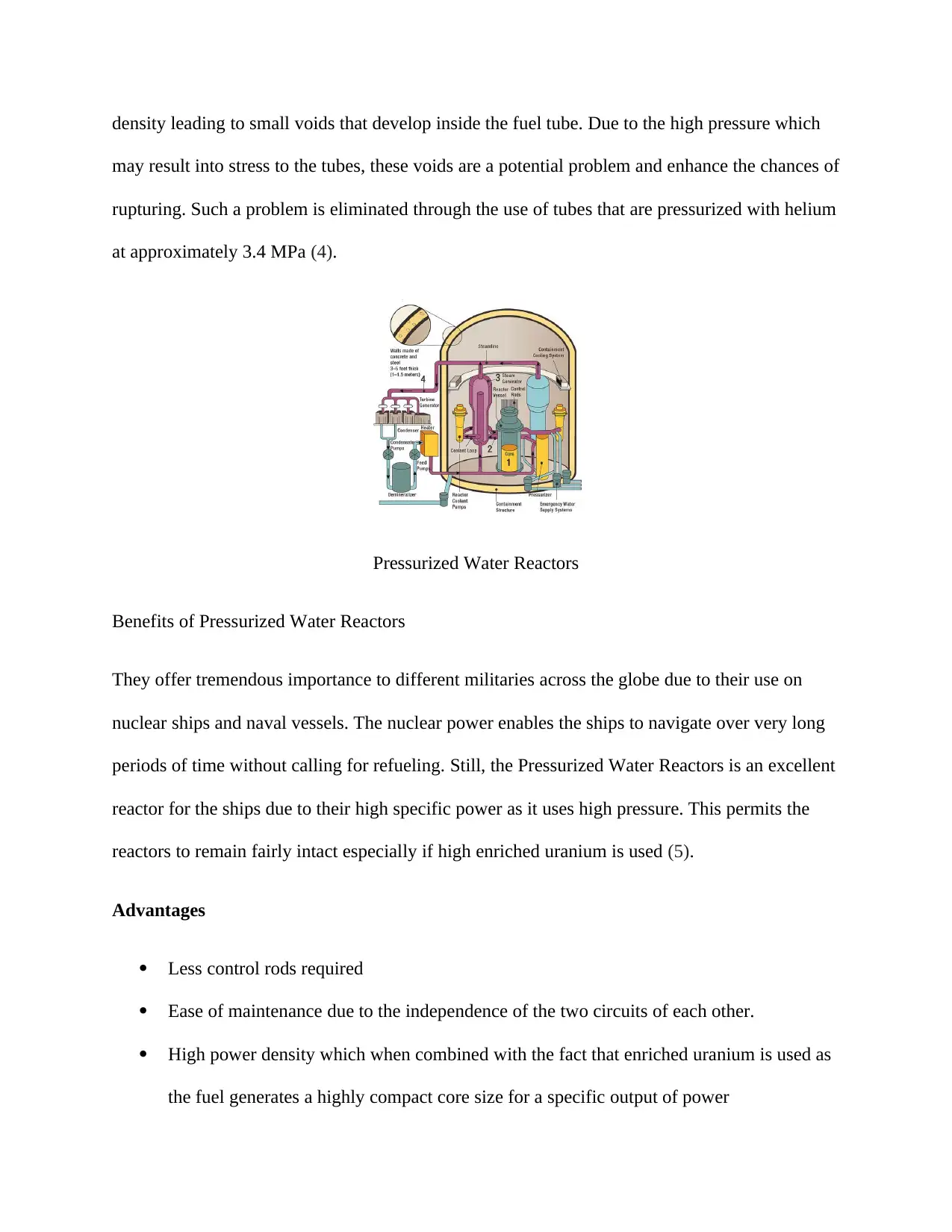
density leading to small voids that develop inside the fuel tube. Due to the high pressure which
may result into stress to the tubes, these voids are a potential problem and enhance the chances of
rupturing. Such a problem is eliminated through the use of tubes that are pressurized with helium
at approximately 3.4 MPa (4).
Pressurized Water Reactors
Benefits of Pressurized Water Reactors
They offer tremendous importance to different militaries across the globe due to their use on
nuclear ships and naval vessels. The nuclear power enables the ships to navigate over very long
periods of time without calling for refueling. Still, the Pressurized Water Reactors is an excellent
reactor for the ships due to their high specific power as it uses high pressure. This permits the
reactors to remain fairly intact especially if high enriched uranium is used (5).
Advantages
Less control rods required
Ease of maintenance due to the independence of the two circuits of each other.
High power density which when combined with the fact that enriched uranium is used as
the fuel generates a highly compact core size for a specific output of power
may result into stress to the tubes, these voids are a potential problem and enhance the chances of
rupturing. Such a problem is eliminated through the use of tubes that are pressurized with helium
at approximately 3.4 MPa (4).
Pressurized Water Reactors
Benefits of Pressurized Water Reactors
They offer tremendous importance to different militaries across the globe due to their use on
nuclear ships and naval vessels. The nuclear power enables the ships to navigate over very long
periods of time without calling for refueling. Still, the Pressurized Water Reactors is an excellent
reactor for the ships due to their high specific power as it uses high pressure. This permits the
reactors to remain fairly intact especially if high enriched uranium is used (5).
Advantages
Less control rods required
Ease of maintenance due to the independence of the two circuits of each other.
High power density which when combined with the fact that enriched uranium is used as
the fuel generates a highly compact core size for a specific output of power
Paraphrase This Document
Need a fresh take? Get an instant paraphrase of this document with our AI Paraphraser
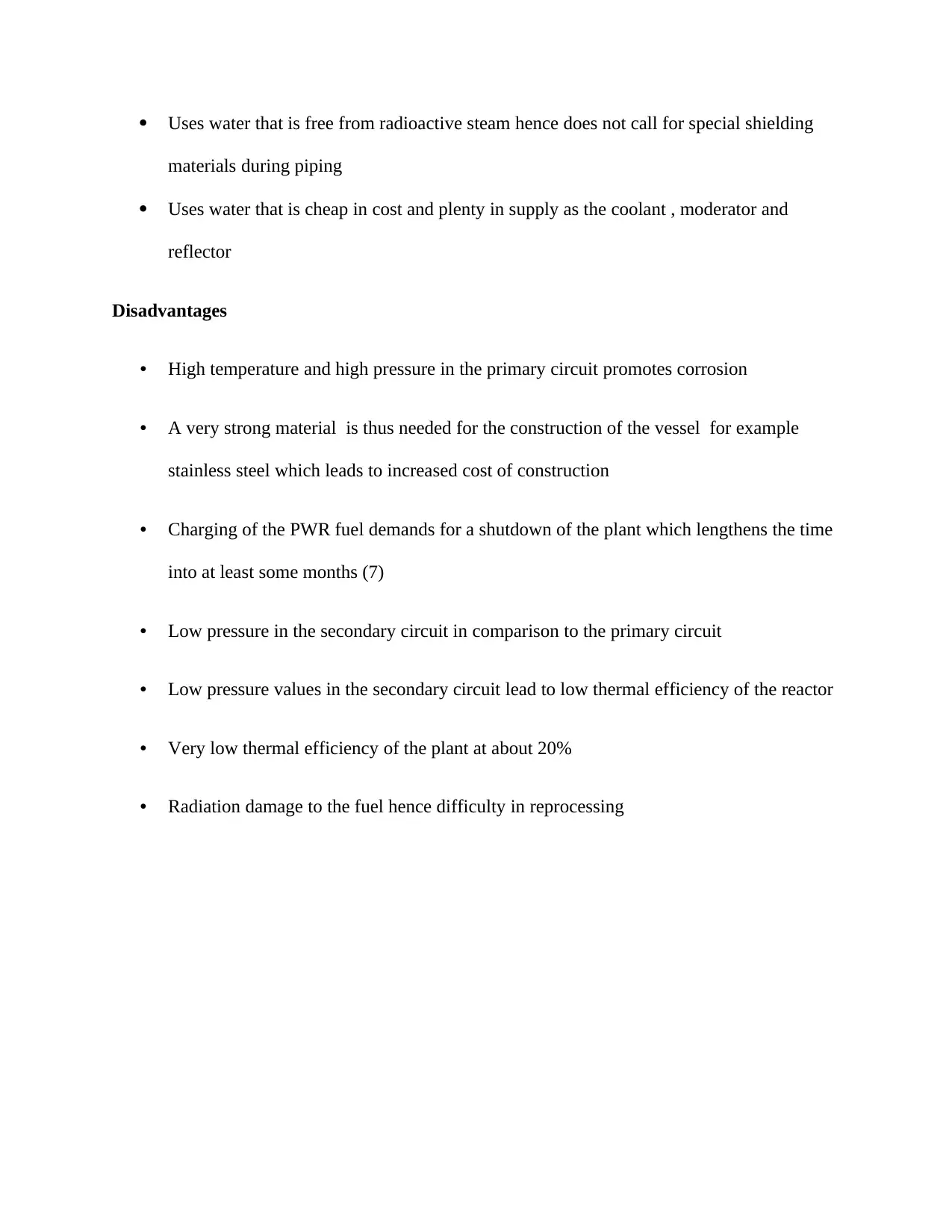
Uses water that is free from radioactive steam hence does not call for special shielding
materials during piping
Uses water that is cheap in cost and plenty in supply as the coolant , moderator and
reflector
Disadvantages
• High temperature and high pressure in the primary circuit promotes corrosion
• A very strong material is thus needed for the construction of the vessel for example
stainless steel which leads to increased cost of construction
• Charging of the PWR fuel demands for a shutdown of the plant which lengthens the time
into at least some months (7)
• Low pressure in the secondary circuit in comparison to the primary circuit
• Low pressure values in the secondary circuit lead to low thermal efficiency of the reactor
• Very low thermal efficiency of the plant at about 20%
• Radiation damage to the fuel hence difficulty in reprocessing
materials during piping
Uses water that is cheap in cost and plenty in supply as the coolant , moderator and
reflector
Disadvantages
• High temperature and high pressure in the primary circuit promotes corrosion
• A very strong material is thus needed for the construction of the vessel for example
stainless steel which leads to increased cost of construction
• Charging of the PWR fuel demands for a shutdown of the plant which lengthens the time
into at least some months (7)
• Low pressure in the secondary circuit in comparison to the primary circuit
• Low pressure values in the secondary circuit lead to low thermal efficiency of the reactor
• Very low thermal efficiency of the plant at about 20%
• Radiation damage to the fuel hence difficulty in reprocessing
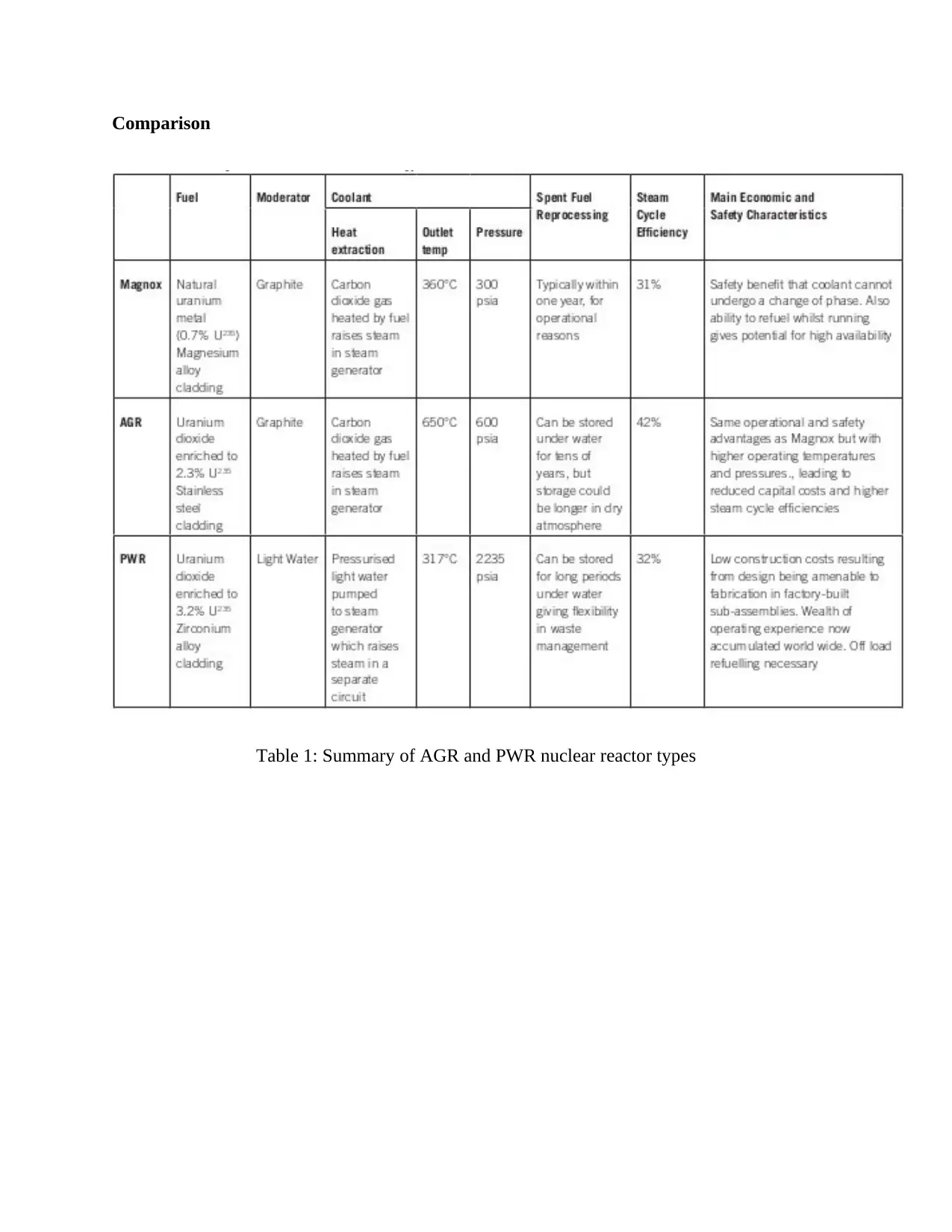
Comparison
Table 1: Summary of AGR and PWR nuclear reactor types
Table 1: Summary of AGR and PWR nuclear reactor types
⊘ This is a preview!⊘
Do you want full access?
Subscribe today to unlock all pages.

Trusted by 1+ million students worldwide
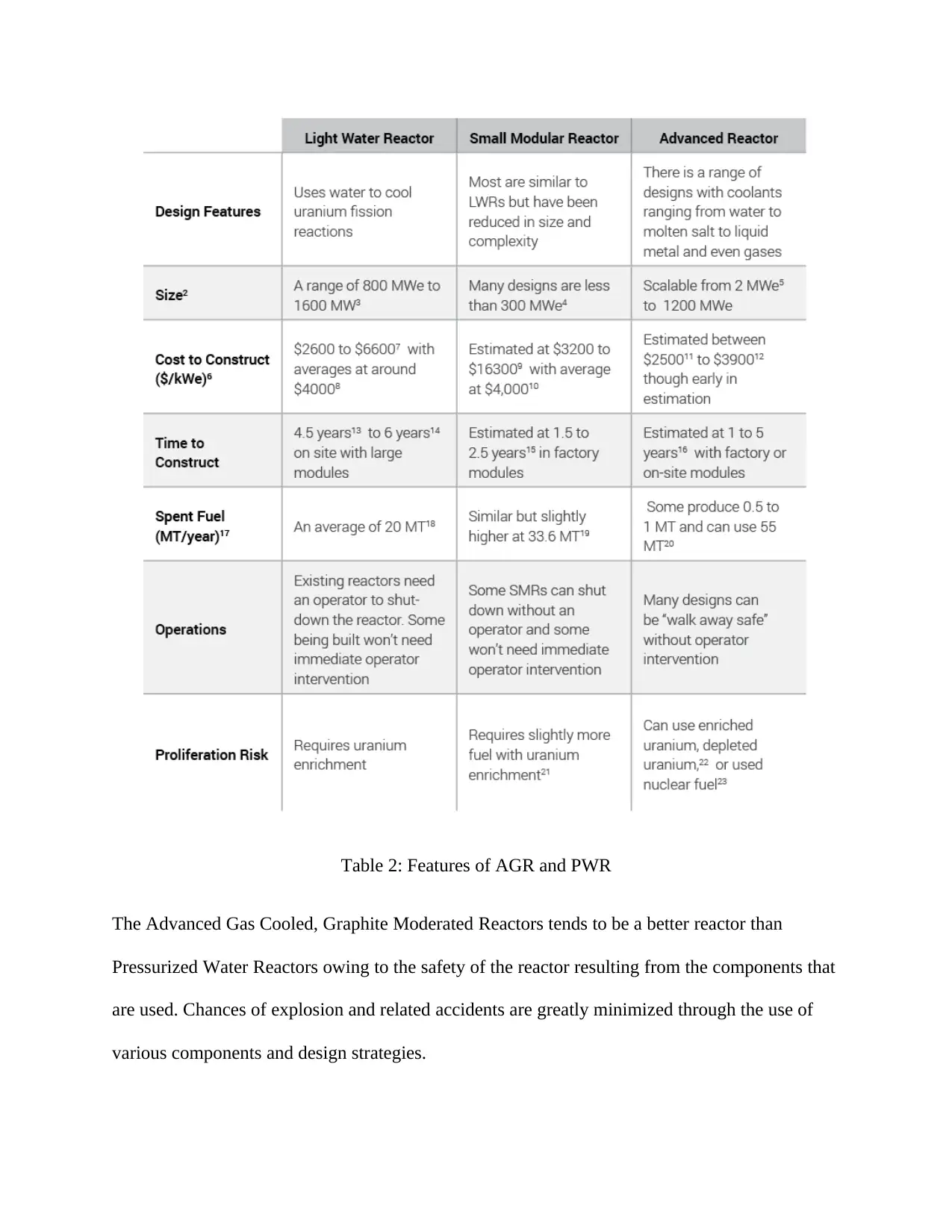
Table 2: Features of AGR and PWR
The Advanced Gas Cooled, Graphite Moderated Reactors tends to be a better reactor than
Pressurized Water Reactors owing to the safety of the reactor resulting from the components that
are used. Chances of explosion and related accidents are greatly minimized through the use of
various components and design strategies.
The Advanced Gas Cooled, Graphite Moderated Reactors tends to be a better reactor than
Pressurized Water Reactors owing to the safety of the reactor resulting from the components that
are used. Chances of explosion and related accidents are greatly minimized through the use of
various components and design strategies.
Paraphrase This Document
Need a fresh take? Get an instant paraphrase of this document with our AI Paraphraser
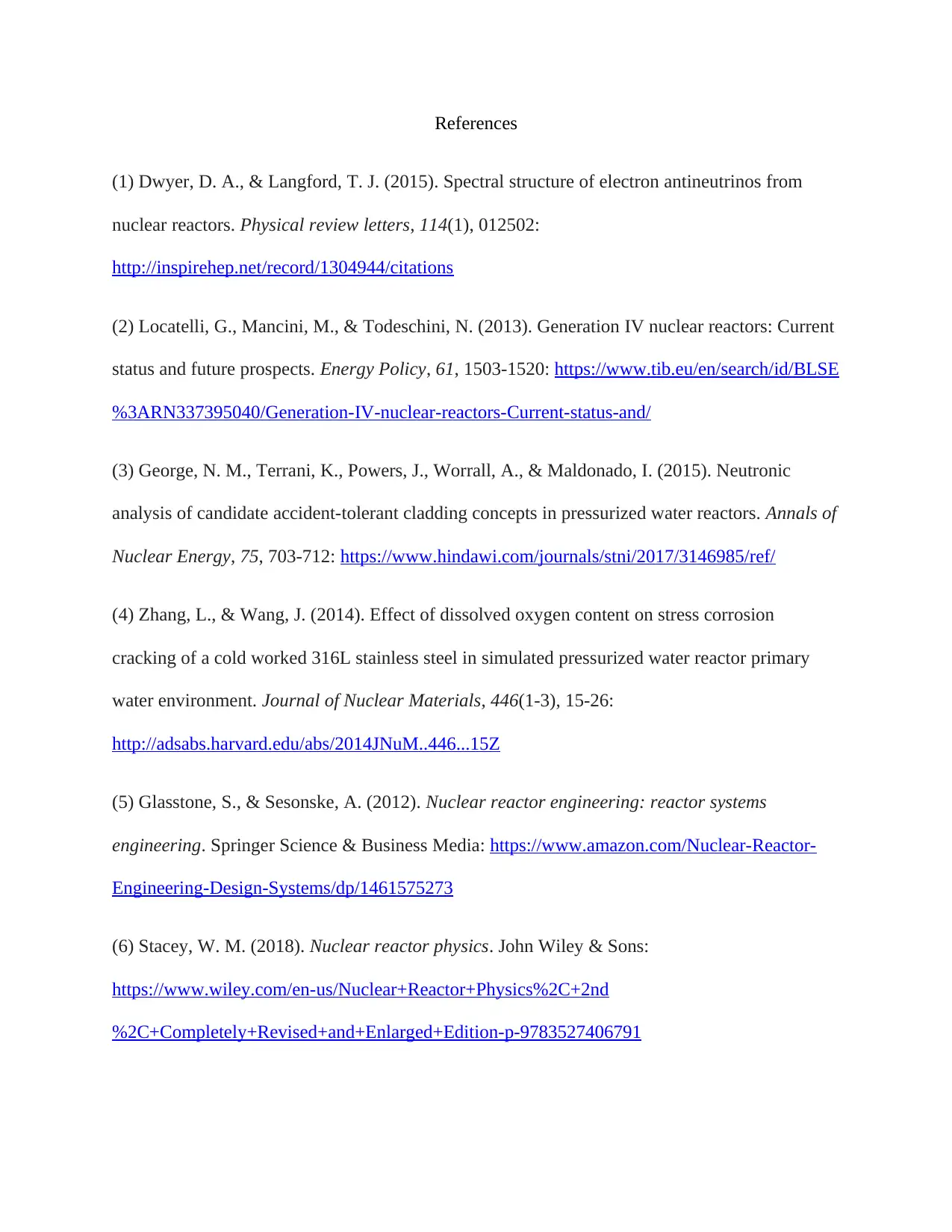
References
(1) Dwyer, D. A., & Langford, T. J. (2015). Spectral structure of electron antineutrinos from
nuclear reactors. Physical review letters, 114(1), 012502:
http://inspirehep.net/record/1304944/citations
(2) Locatelli, G., Mancini, M., & Todeschini, N. (2013). Generation IV nuclear reactors: Current
status and future prospects. Energy Policy, 61, 1503-1520: https://www.tib.eu/en/search/id/BLSE
%3ARN337395040/Generation-IV-nuclear-reactors-Current-status-and/
(3) George, N. M., Terrani, K., Powers, J., Worrall, A., & Maldonado, I. (2015). Neutronic
analysis of candidate accident-tolerant cladding concepts in pressurized water reactors. Annals of
Nuclear Energy, 75, 703-712: https://www.hindawi.com/journals/stni/2017/3146985/ref/
(4) Zhang, L., & Wang, J. (2014). Effect of dissolved oxygen content on stress corrosion
cracking of a cold worked 316L stainless steel in simulated pressurized water reactor primary
water environment. Journal of Nuclear Materials, 446(1-3), 15-26:
http://adsabs.harvard.edu/abs/2014JNuM..446...15Z
(5) Glasstone, S., & Sesonske, A. (2012). Nuclear reactor engineering: reactor systems
engineering. Springer Science & Business Media: https://www.amazon.com/Nuclear-Reactor-
Engineering-Design-Systems/dp/1461575273
(6) Stacey, W. M. (2018). Nuclear reactor physics. John Wiley & Sons:
https://www.wiley.com/en-us/Nuclear+Reactor+Physics%2C+2nd
%2C+Completely+Revised+and+Enlarged+Edition-p-9783527406791
(1) Dwyer, D. A., & Langford, T. J. (2015). Spectral structure of electron antineutrinos from
nuclear reactors. Physical review letters, 114(1), 012502:
http://inspirehep.net/record/1304944/citations
(2) Locatelli, G., Mancini, M., & Todeschini, N. (2013). Generation IV nuclear reactors: Current
status and future prospects. Energy Policy, 61, 1503-1520: https://www.tib.eu/en/search/id/BLSE
%3ARN337395040/Generation-IV-nuclear-reactors-Current-status-and/
(3) George, N. M., Terrani, K., Powers, J., Worrall, A., & Maldonado, I. (2015). Neutronic
analysis of candidate accident-tolerant cladding concepts in pressurized water reactors. Annals of
Nuclear Energy, 75, 703-712: https://www.hindawi.com/journals/stni/2017/3146985/ref/
(4) Zhang, L., & Wang, J. (2014). Effect of dissolved oxygen content on stress corrosion
cracking of a cold worked 316L stainless steel in simulated pressurized water reactor primary
water environment. Journal of Nuclear Materials, 446(1-3), 15-26:
http://adsabs.harvard.edu/abs/2014JNuM..446...15Z
(5) Glasstone, S., & Sesonske, A. (2012). Nuclear reactor engineering: reactor systems
engineering. Springer Science & Business Media: https://www.amazon.com/Nuclear-Reactor-
Engineering-Design-Systems/dp/1461575273
(6) Stacey, W. M. (2018). Nuclear reactor physics. John Wiley & Sons:
https://www.wiley.com/en-us/Nuclear+Reactor+Physics%2C+2nd
%2C+Completely+Revised+and+Enlarged+Edition-p-9783527406791
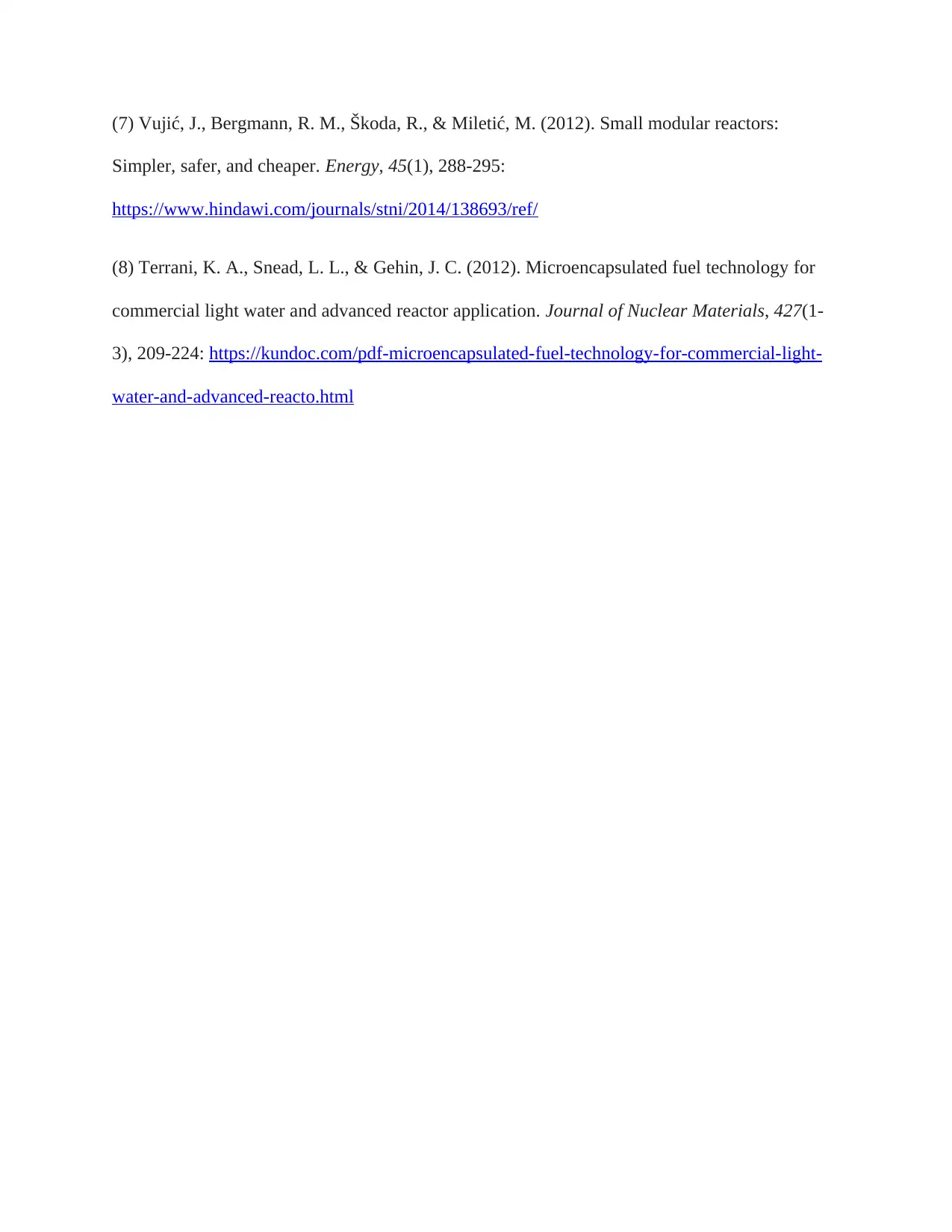
(7) Vujić, J., Bergmann, R. M., Škoda, R., & Miletić, M. (2012). Small modular reactors:
Simpler, safer, and cheaper. Energy, 45(1), 288-295:
https://www.hindawi.com/journals/stni/2014/138693/ref/
(8) Terrani, K. A., Snead, L. L., & Gehin, J. C. (2012). Microencapsulated fuel technology for
commercial light water and advanced reactor application. Journal of Nuclear Materials, 427(1-
3), 209-224: https://kundoc.com/pdf-microencapsulated-fuel-technology-for-commercial-light-
water-and-advanced-reacto.html
Simpler, safer, and cheaper. Energy, 45(1), 288-295:
https://www.hindawi.com/journals/stni/2014/138693/ref/
(8) Terrani, K. A., Snead, L. L., & Gehin, J. C. (2012). Microencapsulated fuel technology for
commercial light water and advanced reactor application. Journal of Nuclear Materials, 427(1-
3), 209-224: https://kundoc.com/pdf-microencapsulated-fuel-technology-for-commercial-light-
water-and-advanced-reacto.html
⊘ This is a preview!⊘
Do you want full access?
Subscribe today to unlock all pages.

Trusted by 1+ million students worldwide
1 out of 12
Your All-in-One AI-Powered Toolkit for Academic Success.
+13062052269
info@desklib.com
Available 24*7 on WhatsApp / Email
![[object Object]](/_next/static/media/star-bottom.7253800d.svg)
Unlock your academic potential
Copyright © 2020–2025 A2Z Services. All Rights Reserved. Developed and managed by ZUCOL.
